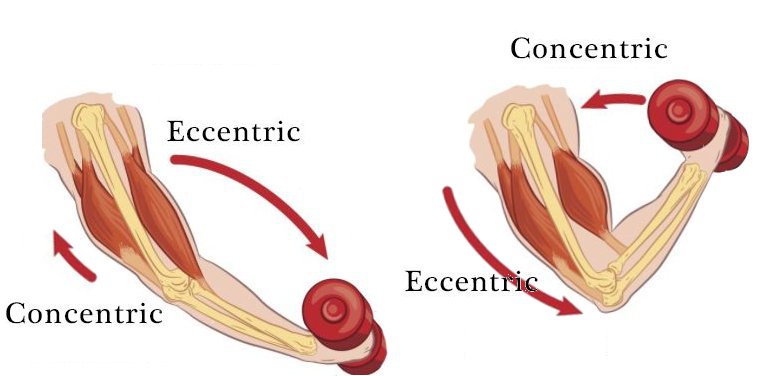Lengthening and Shortening
Concentric and Eccentric Contractions
Well, as far as horses go, you might be expecting me to be talking about cavaletti! And they are fabulous for
this! Anything where the horse is figuring out and deciding for itself what to do, we can start having communication,
and that makes my life easy.
These next few pages, though, are going to be more about the person. And, depending upon your background, maybe
a little bit more of a mind-bender.
Background
My very simple idea of muscles was that they contracted or they relaxed. And for me, contraction meant get
bunchy and shorter. Relaxed meant they let go of being contracted and went back to whatever shape they started
in. OR, if the agonist (okay, is that like agony?) muscle was bunching up, the antagonist muscle would relax
and passively stretch. (Mind you, you, the person, would be actively contracting, as in bunching up, something,
the agonist muscle and the antagonist muscle would be 'passively' 'stretching.')
Muscles worked in pairs and took turns being bunchy or
getting stretched by the bunchy muscle.
Enter in some education.
Firstly, muscles don't actually stretch like silly putty.
Maybe you knew that. They change shape by
rearranging spindles, by sliding them past each other.
Theoretically.
Maybe that'll come in one of the follow on pages ...
Here's the practical part:
Lengthening is a Contraction, too
Well, knock me over with a feather.
The easiest way for me to understand this is that if you
lifted you arm, say to pick up a halter, the you're
contracting the muscles on top of the arm to lift it.
So far, so good.
When you go to put the halter down, you're now also
contracting your muscles. (?) While they're getting
longer. (?)
Which, makes sense when you really pay attention.
If you weren't contracting your muscles as you put the
halter down, gravity would take over and your arm and the
halter would fall like a rock. Which generally it
doesn't. The slowing of the descent is because the
muscles on top are contracting.
Of course, there's names for this. When the muscle
gets longer, it's called eccentric
contraction. When it gets shorter, it's
called a concentric contraction.
Muscles can do both, sometimes contracting eccentrically and
sometimes contracting concentrically. Short and
bunchy: Concentric.
Long and lean: Eccentric.
 |
Biceps is lengthening with Eccentric
Contraction.
Triceps is shortening with Concentric Contraction. |
|
Biceps is shortening with Concentric
Contraction.
Triceps is lengthening with Eccentric Contraction. |
It's easier for me to think of lengthening contractions
when I'm preventing a limb from clanging back down to the
ground, but it can also happen when limbs are being lifted.
This is where it gets interesting.
Something to Experiment With
Exploration 1: Lifting the weight up (you don't really
need a weight!)
|
first part: movement by
concentric only
Doing a curl, lifting the hand towards the shoulder, the
bicep muscle is contracting concentrically. (getting
bunchy.)
How does it feel if, as you do this, you pretend the
bottom muscles are doing nothing other than getting
stretched by the action of the top muscles?
contrasted with: movement by
eccentric only
While doing a curl, lifting the hand towards the shoulder,
with the bicep muscle 'along for the ride,' how does it feel
if, as you do this, you pretend the bottom muscles are
lengthening actively and in doing so pushing the elbow away
from the shoulder, levering the lower arm up into the air?
contrasted with: movement by
concentric and eccentric
While doing a curl, lifting the hand towards the shoulder,
with the bicep muscle is contracting concentrically, how
does it feel if, as you do this, you pretend the bottom
muscles are lengthening actively and in doing so pushing the
elbow away from the shoulder, levering the lower arm up into
the air?
|

|
Exploration 2: Lowering the weight
first part: movement by
concentric only
Doing a curl, moving the hand away from the shoulder, the
triceps muscles are contracting
concentrically. (getting bunchy.)
How does it feel if, as you do this, you pretend the
bicep muscle is doing nothing other than getting stretched
by the action of the triceps?
contrasted with: movement by
eccentric only
While doing a curl, moving the hand away from the shoulder,
the triceps muscles are 'along for the ride,' how does if
feel if, as you do this, you pretend the biceps are
lengthening actively and in doing so pushing the forearm
away from the shoulder?
contrasted with: movement by
concentric and eccentric
While doing a curl, moving the hand away from the shoulder,
the triceps muscles are contracting concentrically (and
getting bunchy,) how does if feel if, as you do this, you
pretend the bicep muscle is lengthening actively and in
doing so pushing the forearm away from the shoulder?
|
 |
Did anything about this surprise you? Or
change how your arm moved? Was one way easier
than another? More fluid? With greater
range of motion?
Similar explorations can be done observing the
swing of the lower leg under the upper leg, or the leg
in its entirety any time you're walking or running. Or with any set of
muscles. Any time your moving your
bones. Like during stretching, yoga, dancing, or
riding.
The "New" Idea
What if the muscle lengthening,
eccentric contraction, contributes to changes in
the relationships between bones? What if it's not just a
matter of muscles getting short and bunchy, dragging the
other muscles into a "stretch." It's not only about
concentric contractions. And maybe eccentric
contraction isn't only about defying gravity. What if
eccentric contractions happen all the time?
Did you give this a whirl? What
did you notice? Share if you like!
More to come!
Lynn
4/1/20
|